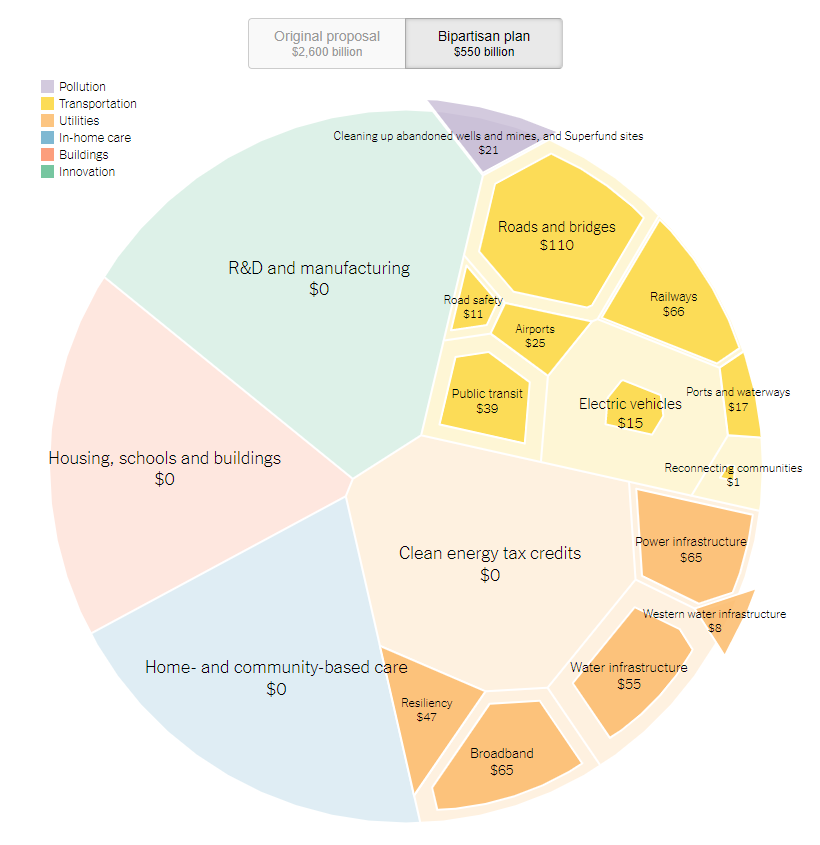Climate Deep Dive Series
On Friday, the House of Representatives passed the $1.2tn Infrastructure Investment and Jobs Act, containing $550bn of new spending over eight years. It is a slimmed down version of the original $2.6tn plan. Here are some of the key components of the bill:

A rough overview of the remaining allocation breakdown. Source: NYTimes - The Infrastructure Plan: What’s In and What’s Out
$283bn for Transportation
- $110bn for roads, bridges, and other major projects. $40bn is allocated for bridges and $17.5bn for major projects. This also includes transportation research, congestion relief, and reconnecting communities.
- $105bn for modernizing public transit. $66bn will go to passenger and freight rail and $39bn to other public transit systems. Some experts estimate there is a $176bn public transit investment backlog.
- $42bn for airports and ports. $25bn for airports and $17bn for ports to improve infrastructure, address repair and maintenance backlogs, reduce congestion and emissions, and drive electrification and other low-carbon technologies.
- $15bn for vehicles. $5bn is for electric vehicle charging stations and $5bn is for electric buses and ferries. Low-emission buses and alternative fueling infrastructure each get $2.5bn.
- $11bn for transportation safety programs. This seeks to reduce crashes and fatalities, especially for pedestrians and cyclists.
$131bn for Water, Resiliency & Environmental Remediation
- $63bn for water infrastructure. This is primarily for upgrading aging infrastructure, replacing lead pipes, and chemical cleanup (particularly PFAS). $8bn is dedicated to drought resilience in the West.
- $47bn for climate resilience and cyber security. These funds will go to preparations for fire, floods, storms, and other extreme weather events. The federal government anticipates resilience adaptation to cost tens to hundreds of billions of dollars per year.
- $21bn for environmental remediation. This focuses on cleaning up contaminated and hazardous sites, reclaiming abandoned mine land, and capping the over 2 million orphan gas wells. Critics argue that the latter might incentivize the oil and gas industry to pass along the costs to taxpayers.
$130bn* for Power & Broadband
- $65bn* for power and grid. According to the most recent White House fact sheet, this is focused on transmission, R&D, and smart grid technology. Around half of the funds will go towards developing supply chains for clean energy technologies and investment in various technologies and fuels (see “Other Important Notes for more). *Note: this value is also reported as $73bn in recent articles and an earlier White House factsheet.
- $65bn for broadband. This is primarily aimed at rural areas and places without easy access. Of the several programs, the largest allocations are $42bn for deployment and $14bn for subsidizing access for low-income households.
Other Important Notes
- $9.5bn for clean hydrogen. $8bn will go to the creation of four “hydrogen hubs”, $1bn to reduce the cost of green hydrogen, and $500mn in project grants.
- $8bn for carbon capture and storage. $3.5bn will go to four “direct air capture hubs” and much of the rest will go to developing the infrastructure required to scale the technologies and store carbon.
- $6bn for nuclear. This will primarily be split between credits to support existing power plants and the Advanced Reactor Demonstration Program.
- $6bn for batteries. $3bn is for battery materials processing and $3 billion is for battery manufacturing and recycling.
Additional Resources:
There are many other interesting and smaller allocations within the bill (e.g., NOAA received $500mn to improve maps of inland and coastal flooding, $150mn for the Long-Duration Demonstration Initiative, etc.). To learn more, here are some resources to start:
- The Infrastructure Investment and Jobs Act
- Nov 8 White House Factsheet
- FT - House passes Joe Biden’s $1.2tn bipartisan infrastructure bill
- NYTimes – The Infrastructure Plan: What’s In and What’s Out
- Grist - The House just passed a major infrastructure bill. Here’s what’s in it.
- Axios - House passes $1.2T bipartisan infrastructure bill, sending it to Biden's desk
- Canary Media - How the infrastructure bill will fight climate change and advance clean energy
- NYTimes - Infrastructure Bill Makes First Major U.S. Investment in Climate Resilience
- Akin Gump - Infrastructure Investment and Jobs Act: Summary of Key Programs and Provisions